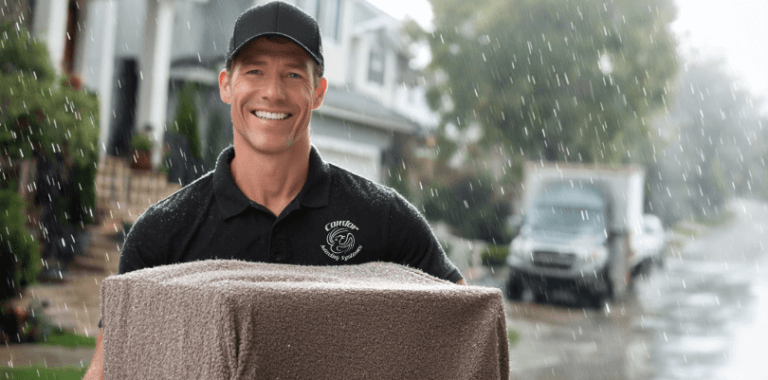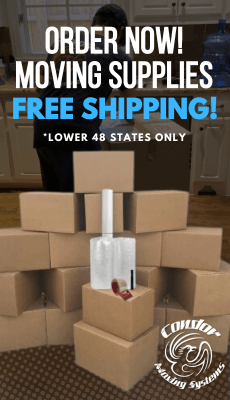
Moving day doesn’t always come with perfect weather—and sometimes, rain shows up whether you’re ready for it or not. While a wet forecast can make the process more challenging, the good news is that a little preparation goes a long way. With the right supplies, smart planning, and a few protective measures, you can keep your belongings safe and your move running smoothly. Here are 10 practical tips to help you handle moving in the rain like a pro.
1. Use Waterproof Packing Supplies
Rain and cardboard don’t mix well, so it’s important to choose materials that can handle moisture. Invest in plastic bins for valuable or fragile items, and use heavy-duty trash bags to protect clothing, bedding, and other soft goods. For standard cardboard boxes, reinforce them with extra packing tape along the seams to prevent them from weakening or falling apart. A small step in packing smart can save you from a big headache when the skies open up.
2. Protect Furniture With Plastic Wrap
Large items like couches, mattresses, and wooden furniture are especially vulnerable to water damage. Cover them in plastic wrap, shrink wrap, or waterproof moving blankets to create a barrier against the rain. Even a light drizzle can leave stains or warp wood, so wrapping your furniture before it leaves the house ensures it stays dry and protected throughout the move.
3. Double-Box Fragile Items
Fragile belongings like glassware, dishes, or collectibles need extra protection on a rainy day. Use the double-boxing method—placing a smaller, well-padded box inside a larger one—to add an extra layer against moisture and impact. Line the outer box with plastic or garbage bags for extra waterproofing, and seal it with heavy-duty tape. This way, even if the outer box gets damp, the inner contents stay safe and secure.
4. Keep Towels and Blankets Handy
When moving in the rain, having a stash of old towels and blankets nearby can be a lifesaver. Use them to quickly dry wet boxes, wipe down furniture, or protect delicate items as they’re carried inside. They also come in handy for drying off hands and keeping walkways less slippery. Think of them as your first line of defense against water sneaking into your move.

5. Cover Floors to Prevent Slips and Mud
Rain doesn’t just affect what you’re moving—it can also make your new and old homes messy and unsafe. Lay down plastic sheets, tarps, or old rugs along entryways and hallways to keep floors dry and protected. This not only prevents mud and water from being tracked inside but also reduces the risk of slipping accidents while carrying heavy boxes or furniture.
6. Load and Unload in Stages to Minimize Exposure
Instead of rushing everything outside at once, organize your move into smaller, controlled stages. Keep boxes and furniture inside until the truck is ready for loading, then move items in batches under umbrellas, tarps, or covered walkways if possible. This strategy limits how long your belongings are exposed to the rain and keeps everything drier overall.
7. Create a Dry Staging Area Inside
Set up a designated spot near the entrance of your home—like the garage, foyer, or covered porch—where items can be placed before being carried out to the truck. This staging area helps keep boxes and furniture from sitting in the rain while movers load or unload. It also makes the process more efficient, since everything is ready to go in one organized location.
8. Wear Non-Slip Shoes and Weather-Resistant Clothing
Safety should always come first on a rainy moving day. Choose shoes with good traction to prevent slips on wet driveways, ramps, or stairs. Waterproof jackets and gloves will also keep you dry and comfortable, making it easier to handle boxes without losing your grip. Dressing for the weather keeps you safe while also helping the move stay on schedule.

9. Protect Electronics and Important Documents Separately
Electronics, photos, and paperwork are especially vulnerable to water damage. Pack laptops, tablets, and important files in waterproof cases or sealable plastic bags, then carry them separately instead of loading them with the rest of the boxes. Keeping these items close ensures they stay dry, safe, and easily accessible during the move.
10. Have a Backup Plan in Case of Severe Weather
Sometimes rain is just inconvenient—but other times, it can be dangerous. If the forecast calls for heavy storms, flooding, or lightning, have a contingency plan ready. This could mean delaying the move, renting protective gear, or arranging temporary storage. Flexibility is key to keeping both your belongings and your moving team safe when the weather takes a turn for the worse.
Rain doesn’t have to ruin your moving day. With the right preparation—like waterproofing your belongings, protecting your floors, and planning for safety—you can keep the process smooth and stress-free. Whether it’s a light drizzle or a heavier downpour, these tips will help you stay organized and protect what matters most. And if the weather feels overwhelming, remember that professional movers have the experience and equipment to handle rainy-day moves with ease. Condor Moving Systems is a full-service moving company, here to help make your move into history as smooth and stress-free as possible!
Call us at (877) 460-6683 or
Request your free moving quote at www.condormovingsystems.com



